
Editor's note: The Does God Exist? ministry gives $1000 scholarships every year for post-secondary education. To win the scholarship, participants must enter a 5,000 word (or less) essay on the topic “Science Is a Friend of Faith — Not an Enemy.” Our winning essay for 2014 was submitted by Darrick Anderson.
The Bible very clearly identifies God as the Creator of the heavens and the earth. On the other hand, for years science has appeared to contradict this claim, and scientists have taught that the universe was eternal and did not need a creator. Carl Sagan, a noted scientist and atheist, expressed the sentiment of many skeptics when he said, “… if God wanted to send us a message, and ancient writings were the only way he could think of doing it, he could have done a better job.” 1 Why does not the Bible give us more details or tell us exactly how and when God did this along with the specific processes that he used to create all that we see?
Unfortunately for those craving scientific facts, the Bible's goal is not to teach science. However, it is the history book of the universe. It tells us how the universe began and how it came to be the way that it is. It was written by inspiration of God. The Lord knows how the universe works. He made it. Unlike science textbooks, the Bible never changes or has to be revised. God got it right the first time concerning every topic that it covers.
The Genesis account of creation is brief and unsatisfying from a scientific point of view. However, communicating these facts was not God's real reason for giving us the book of Genesis. The greatest need of the human heart is not to know just when or how the universe was created but who created it. God's purpose was to reveal who he is and to magnify himself as sole Creator. Nevertheless, believers do not have to suspend reason to follow Christ. There is plenty of biblical support for science and vice versa.
For years, well-meaning Christians have believed and taught that the Bible must be the only source of truth for all things — religious and secular. This has led many to believe that science is of the devil, or any attempt to gain knowledge from other sources is sinful. However, this position runs contrary to Scripture itself. Psalm 19:1 – 4 tells us that God also speaks through his creation.
Science is basically the study of all that God has made, and the Scriptures declare that the physical world reveals the great power of an invisible God (Romans 1:19 – 20). This precept alone should comfort the faithful with the knowledge that science can only observe and comment on what God has already done. A Christian does not have to turn his back on scientific findings or discoveries in order to be true to his faith. He only has to conscientiously think through the issues that science presents. He will then discover that the consensus of the modern scientific community is that the universe had a beginning — a creation event as they say. This is in agreement with the ancient writings of the Bible stating that the universe is not eternal but was created by a transcendent, omnipotent God. The same conclusion that men of faith have arrived at through the Word of God, men of science have now found inescapable through several lines of overwhelming scientific evidence — the laws of thermodynamics, Einstein's general theory of relativity, and observations of astronomy.
It is important to point out that while there is no conflict between science and the Bible, there is a conflict between science and some traditional beliefs among many Christians. According to practically all of the sciences (geography, physics, astronomy, etc.), the universe appears to be very old. However, many Christians have come to believe in a recent creation tradition which forces them to reject any scientific findings contrary to the belief that the universe was created within the last 10,000 years.
 Some may argue that this belief is not a tradition but is based on the clear teaching of the Bible. However, history reveals that recent creation tradition stems from the teachings and methods of James Ussher (1581 – 1656), Irish Archbishop of Armagh. He used the genealogies found in Genesis and other portions of the Bible to conclude that there were 4,036 years from the creation of the universe until the birth of Christ. Another scholar, John Lightfoot (1602 – 1675) further refined Ussher's calculations and figured that Genesis 1:1 occurred on October 18, 4004 B.C., and Adam was created on October 23 at 9:00 A.M. This date for creation became a part of Protestant tradition even showing up in early printings of the Authorized King James Version of the Bible as a margin note and heading.
Some may argue that this belief is not a tradition but is based on the clear teaching of the Bible. However, history reveals that recent creation tradition stems from the teachings and methods of James Ussher (1581 – 1656), Irish Archbishop of Armagh. He used the genealogies found in Genesis and other portions of the Bible to conclude that there were 4,036 years from the creation of the universe until the birth of Christ. Another scholar, John Lightfoot (1602 – 1675) further refined Ussher's calculations and figured that Genesis 1:1 occurred on October 18, 4004 B.C., and Adam was created on October 23 at 9:00 A.M. This date for creation became a part of Protestant tradition even showing up in early printings of the Authorized King James Version of the Bible as a margin note and heading.
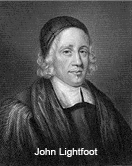 Neither Ussher nor Lightfoot recognized that in the Old Testament the Hebrew words for father ('ab) and son (ben) can also mean forefather or descendant. Nonetheless, these dates have become ingrained into much Christian thinking. This is in spite of the fact that fossil evidence, radioactive dating of rocks, and the ability to see light from galaxies light-years away renders this view unreasonable. Proponents of the young-earth school of thought have tried to get out of this dilemma by proposing that God created everything with an appearance of age, even though the Bible and geology testify to a progressive creation. Both tell us that the earth was once “formless and empty” and that this condition was followed by a primitive, universal ocean which in turn was followed by the appearance of dry land. 2
Neither Ussher nor Lightfoot recognized that in the Old Testament the Hebrew words for father ('ab) and son (ben) can also mean forefather or descendant. Nonetheless, these dates have become ingrained into much Christian thinking. This is in spite of the fact that fossil evidence, radioactive dating of rocks, and the ability to see light from galaxies light-years away renders this view unreasonable. Proponents of the young-earth school of thought have tried to get out of this dilemma by proposing that God created everything with an appearance of age, even though the Bible and geology testify to a progressive creation. Both tell us that the earth was once “formless and empty” and that this condition was followed by a primitive, universal ocean which in turn was followed by the appearance of dry land. 2
Traditional beliefs may have been contrary to modern scientific understanding, but the Bible is not. This is an important point to keep in mind when viewing the vast times and distances that are used to describe the universe. How great our God is to do all that we see? We can only begin to understand the means he used to do it.
The laws of thermodynamics are a beginning to seeing that science is only a description of God's handiwork and not an alternative view of creation. The first, called the law of conservation of mass and energy, states that matter and energy can neither be created nor destroyed. According to this description of what holds true in our present physical universe, matter and energy may each be converted to the other but neither can appear from nothing. This law seems to conflict with the Bible because there is no denying that the universe is here, and the Bible claims that nothing existed before God created everything. However, if a believer looks closely at the law of conservation of mass and energy, he will discover that instead of contradicting the Word of God it supports the inspired statements of Scripture.
First, no one denies that the creation of the universe was a miraculous event. When God created the universe he created a new thing; so, of course, new laws would apply. The law of conservation of mass and energy describes what we see operating today, and it is true that matter does not spring from nothing today. Therefore, to say that no new matter is being created spontaneously today is to agree with the Bible in Genesis 2:1 where it says that the “heavens and the earth were finished” and that God “rested” from his work of creation.
The second law of thermodynamics tells us that our universe is wearing down, and matter is, and will continue to become more and more dispersed — less and less structured. This scientific law or precept is simply an observation of what we see happening all around us. Our treasured possessions are rusting and turning to dirt, our bodies are wearing down, the sun and stars are burning up tons of hydrogen fuel every second, and earth's magnetic field is decaying. Everywhere that you look the universe is dissipating. Therefore, we know that the universe cannot be eternal. Otherwise, it would have run down long ago. The stars would have burned out, and all matter would have decayed to a few elements. This law clearly points to a beginning — a highly structured and ordered beginning at that.
As human beings, we are like a person who walks into a room right after someone spins a top and walks out another door. We are able to observe the top spinning, but not who set it in motion in the first place. After carefully observing the top, we may note the skill of the “other” in spinning the top, but we can also see the effects that other forces have on the top causing it to slow and wobble.
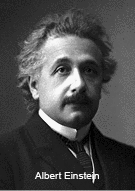 Our universe is slowing down and beginning to wobble. The second law of thermodynamics describes and predicts this phenomenon. Inspired writers of the Bible have been in full agreement with this law for over two millennia. Communicating the clear message that our universe is “wearing out” and “… the heavens are the work of your hands. They will perish, but you remain, they will all wear out like a garment”
(Psalm 102:25, 26; Isaiah 34:4; 51:6).
Our universe is slowing down and beginning to wobble. The second law of thermodynamics describes and predicts this phenomenon. Inspired writers of the Bible have been in full agreement with this law for over two millennia. Communicating the clear message that our universe is “wearing out” and “… the heavens are the work of your hands. They will perish, but you remain, they will all wear out like a garment”
(Psalm 102:25, 26; Isaiah 34:4; 51:6).
Another area in which the scientific community is a friend of faith in the Bible involves Einstein's general theory of relativity. Few people possess the high-level intelligence required to thoroughly understand Einstein's theory, but for the layman two main points are important. First, the equations of general relativity imply that the universe cannot be static, but must be expanding or contracting. Secondly, every verifiable prediction that it makes has been proven correct.
In the general theory of relativity, published in 1915, Einstein reasoned that gravity could not be an attractive force like Isaac Newton and other scientists had thought. He explained the force of gravity as a consequence of the effect of mass on space/time. The gravitational force of great masses like the sun can be pictured, not as a force of attraction tugging on other objects, but as a great mass curving the space around it, forcing each planet to follow a path that is as straight as it can go in curved space. His initial predictions held that if there were enough mass in the universe and it was not too dispersed, the mass would cause all of space to curve in on itself until the universe becomes closed. The other possibility is that if the density of the universe is lower than a critical amount, then all the bodies of the universe should fly apart from one another. The universe should be expanding and decelerating with time.
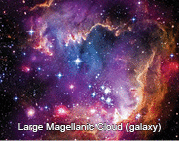 Einstein tried to get away from this idea because it implied a beginning, but was forced to concede to this inescapable conclusion after other scientists began to review his findings. He became convinced of the necessity of a beginning — a creation event. Astronomer Edwin Hubble (1889 – 1953) later confirmed the expansion of the universe through telescopic observation. After this Einstein wrote about his desire “… to know how God created this world. I am not interested in this or that phenomena, in the spectrum of this or that element, I want to know his thought, the rest are details.” 3
Einstein tried to get away from this idea because it implied a beginning, but was forced to concede to this inescapable conclusion after other scientists began to review his findings. He became convinced of the necessity of a beginning — a creation event. Astronomer Edwin Hubble (1889 – 1953) later confirmed the expansion of the universe through telescopic observation. After this Einstein wrote about his desire “… to know how God created this world. I am not interested in this or that phenomena, in the spectrum of this or that element, I want to know his thought, the rest are details.” 3
Since the early 1960s, the effects of general relativity have been confirmed in test after test as it has become possible to precisely measure the expansion of the universe. Science has been upholding the claims of Bible writers for decades. In several passages, the Bible points out that the universe has been “stretched out” or expanded. Isaiah 40:22 says, “He stretches out the heavens like a canopy, and spreads them out like a tent … .” Psalm 104:2 echoes this same idea: “The Lord wraps himself in light as with a garment; he stretches out the heavens like a tent … .” Job 9:8 says, “He alone stretches out the heavens … .” These verses suggest that the universe has increased in size since its creation. God is causing it to expand like points on a balloon that is being inflated. It is amazing to see that scientific discoveries only confirm the biblical record God has given us. The observations of astronomy also provide a bridge between the findings of science and biblical faith. Twentieth century astronomers have recorded significant observations that offer proof for any objective person that the universe had a beginning just as the book of Genesis has detailed for over three millennia.
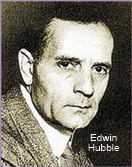 As mentioned earlier in this essay, one man who has contributed to this area of scientific support of the Scriptures is Edwin Hubble. After a decade of boxing, dueling, and World War I combat, this Rhodes Scholar devoted the rest of his life to astronomy. He spent most of the 1920s patiently peering into a 100-inch reflector telescope at California's Mount Wilson Observatory. It was there that he made the discovery that the “nebulae” outside of our galaxy are not nearby gas clouds but are themselves galaxies of stars like our own Milky Way, but at great distances away. After careful observation, he also began to calculate the distances of these star systems using a method of calculation called trigonometric parallax. In 1929, Hubble made the discovery that the galaxies were retreating from each other and that there was a precise, linear relationship between the distance and velocity of the galaxies. This discovery, now known as Hubble's Law, tells us that all distant galaxies are retreating from us with a velocity that is directly proportional to their distance from us. Robert Jastrow, a self-proclaimed agnostic stated, “The Hubble Law is one of the great discoveries in science, and it is one of the main supports of the scientific story of Genesis.” 4
As mentioned earlier in this essay, one man who has contributed to this area of scientific support of the Scriptures is Edwin Hubble. After a decade of boxing, dueling, and World War I combat, this Rhodes Scholar devoted the rest of his life to astronomy. He spent most of the 1920s patiently peering into a 100-inch reflector telescope at California's Mount Wilson Observatory. It was there that he made the discovery that the “nebulae” outside of our galaxy are not nearby gas clouds but are themselves galaxies of stars like our own Milky Way, but at great distances away. After careful observation, he also began to calculate the distances of these star systems using a method of calculation called trigonometric parallax. In 1929, Hubble made the discovery that the galaxies were retreating from each other and that there was a precise, linear relationship between the distance and velocity of the galaxies. This discovery, now known as Hubble's Law, tells us that all distant galaxies are retreating from us with a velocity that is directly proportional to their distance from us. Robert Jastrow, a self-proclaimed agnostic stated, “The Hubble Law is one of the great discoveries in science, and it is one of the main supports of the scientific story of Genesis.” 4
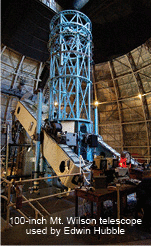 The Bible also says that each star is unique, which is consistent with the observations of astronomy. First Corinthians 15:41 says, “The sun has one kind of splendor, the moon another and the stars another; and star differs from star in splendor.” This is an amazing declaration considering the fact that people living at the time that the Apostle Paul wrote this verse would have had to rely on the naked eye to view the heavens. All stars look alike to the naked eye. However, modern scientific analysis reveals that each star is different and unique. Even though there are millions of known stars in the universe, each one is different. No two stars have the exact same properties. There are many variables in a star's makeup including the total number of atoms, chemical composition, size, temperature, color, and brightness. Sometimes spectroscopic study is required to detect the differences, nevertheless science reveals that the Word of God is true.
The Bible also says that each star is unique, which is consistent with the observations of astronomy. First Corinthians 15:41 says, “The sun has one kind of splendor, the moon another and the stars another; and star differs from star in splendor.” This is an amazing declaration considering the fact that people living at the time that the Apostle Paul wrote this verse would have had to rely on the naked eye to view the heavens. All stars look alike to the naked eye. However, modern scientific analysis reveals that each star is different and unique. Even though there are millions of known stars in the universe, each one is different. No two stars have the exact same properties. There are many variables in a star's makeup including the total number of atoms, chemical composition, size, temperature, color, and brightness. Sometimes spectroscopic study is required to detect the differences, nevertheless science reveals that the Word of God is true.
In conclusion, though science and the Bible have sometimes appeared to be enemies, this is far from the truth. When the claims of science are objectively examined, one will discover that the two are actually friends, not enemies. The laws of thermodynamics, Einstein's general theory of relativity, and observations of astronomy offer three examples of this friendship.
1. Carl Sagan, Contact (New York: Pocket Books, 1985), p. 164.
2. J. W. Dawson, The Origin of the World According to Revelation and Science (New York: Harper Brothers, 1877), pp. 343-357.
3. Albert Einstein cited by Nick Herbert, Quantum Reality — Beyond the New Physics (Garden City, New York: Anchor Press/Doubleday, 1985), p. 177.
4. Robert Jastrow, God and the Astronomers, second edition (New York & London: W. W. Norton & Company, 1992), p. 93.
Picture credits:
© sborisov. Image from BigStockPhoto.com.
https://commons.wikimedia.org/wiki/File:James_Ussher_portrait.jpg.
https://commons.wikimedia.org/wiki/File:John_Lightfoot.jpg.
https://commons.wikimedia.org/wiki/File:Albert_Einstein_(Nobel).png.
© Creativemarc. Image from BigStockPhoto.com.
https://commons.wikimedia.org/wiki/File:Edwin-hubble.jpg.
https://commons.wikimedia.org/wiki/File:100_inch_Hooker_Telescope_900_px.jpg.
